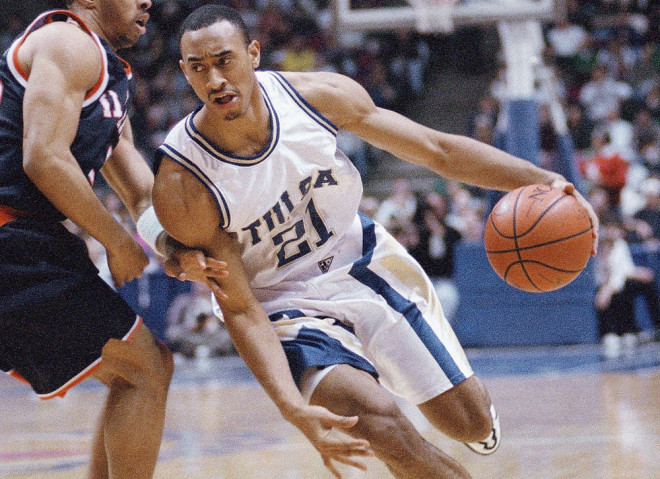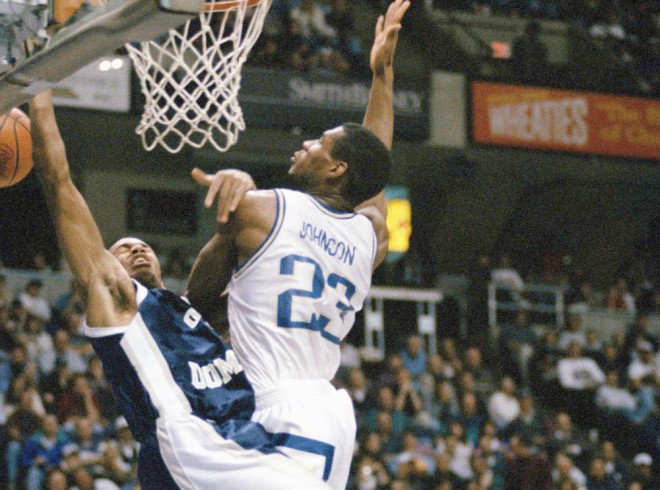Top TU Hoops Recruiting Classes since 1980: No. 5 - 1993

ITS senior writer Larry Lewis counts down the Top Five Tulsa Basketball Recruiting Classes since 1980, starting with the No. 5 class from 1993.
It wasn't a deep class, but with a headliner like Shea Seals, it was one of the most influential recruiting classes in Tulsa basketball history.
The signing of McLain standout Seals for the 1993 class signaled an unparalleled 10-year run in Golden Hurricane history where TU went to three Sweet 16's , including the Elite Eight in 2000, and won first round NCAA games in seven of eight years it went to the tourney. Not to mention an NIT championship.
Besides Seals, the class included Kwanza Johnson, Kevin Grawer and Jay Malham.
It may not look like an overwhelming class, but Seals and Kwanza Johnson put Tulsa over the top.
Coming into the 1993-1994 season, there was good reason for optimism. Tubby Smith had a talented group of nine returning scholarship players. All of the players eligible to return were coming back.
The projected starting lineup of returning players included Gary Collier, Lou Dawkins, Pooh Williamson, Cordell Love and Kerry Wright. The other returnees were J.R. Rollo, Dewayne Bonner, Craig Hernadi and Rafael Maldonado.
Seals reportedly couldn't decide between Seton Hall and Tulsa, and chose Tulsa because of coin flip. When Seals signed in the early signing period in the fall of 1992, Seton Hall was only three years removed from the Final Four, and was coming off Sweet 16 and Elite Eight appearances the previous two seasons.
Since Tulsa had not been to the NCAA tournament since 1987, Seton Hall would have been tough to turn down.
A coach close to Seals asked him, when choosing a college, where would he want to live after he was finished with basketball? Seals was told that where he went to college would be a likely to place to want to settle.
His hometown of Tulsa probably had more appeal than South Orange, New Jersey, despite its close proximity to New York City.
As excited as everybody in Tulsa was about getting Seals, it is doubtful that anybody expected the immediate impact he would have. Maybe an excellent freshman year would be eight to 10 points a game, after averaging 24.4 points per game as a senior for McLain on a McLain team the was the runner-up in the Class 4A state tournament.
The 6-foot-5 Seals scored 33 points in his first game against Houston Baptist, and it was no fluke. He averaged 16.8 points per game as a freshman, and as most TU fans know, he became Tulsa's all-time leading scorer. His jersey was retired. He is third in career steals, and fourth in rebounding and assists.
Johnson was a highly regarded juco transfer from Rose State in Midwest City. He had originally gone to Kansas on a track scholarship before transferring to Rose State, where he averaged 17.5 points, 10.1 rebounds, and two steals, and shot 57% from the field, 40.1% from three-point range, and 71% from the free throw line.
The 6-4 Johnson had jets. The Oklahoma City Marshall grad turned out to be an average shooter, and was kind of a tweener between shooting guard and small forward. But he was a terrific defender, and his athletic ability, combined with smarts and tenacity, would make him an integral part of Tulsa's back-to-back Sweet 16 teams in 1994 and 1995.

Grawer was a 6-foot point guard who is the son of former St. Louis University coach Rich Grawer. Kevin Grawer had transferred from St. Louis to Olney Central College in Illinois after his father was fired after his 10th year as coach of the Billikens.
As a redshirt freshman for SLU, Grawer averaged 3 points and 14 minutes per game. At Olney, he had averages of 14 points and 7 assists, while shooting 56% from the field, 44% on three-pointers, and 84% on free throws.
Mahlam is the younger brother of Jeff Malham, who had just graduated. The younger Malham was 6-6, just like his brother, and was from Broken Arrow.
Jay Malham was a transfer from NEO A&M, where he had averaged 9.5 points and 4 rebounds, and shot 41% from three-point range. He played for St. Gregory's juco in Shawnee as a freshman, where he had averages of 13.1 points and 4.3 rebounds.
Tulsa had lost three seniors from the 1993 season -- Mark Morse, Jeff Malham and Jodie Huffman. All three had averaged in double figures in 1993. Morse averaged 17.4, while Malham and Huffman averaged 14 and 10.8 points, respectively.
Morse had been a dynamic point guard. Malham was a natural wing player who started at center for two years because of the team's lack of size. Huffman was a 6-5 forward.
The 1993 season had been especially frustrating (15-14) because the team had been ineligible for postseason due to previous violations in the track program that put all TU teams on probation for the 1992-1993 school year. The main cause was that the track team wasn't putting enough money into its program.
The legendary 1993-94 team had a starting lineup of Seals, Dawkins, Colllier, Williamson and Rollo. All showed tremendous improvement. Johnson and Maldonado were the first two players off the bench. Hernadi, Grawer and Bonner also got playing time in every game down the stretch.
Collier was the MVC Player of the Year, upping his average from 15 points to 22.9. Dawkins was Valley Defensive Player of the Year, and became a scoring threat, increasing his numbers from 6.1 to 12.5 points. Rollo provided TU with a legitimate center at 7.7 points, up from 2.0.
Williamson was supposed to compete with Grawer for the starting point guard job. But after averaging 2.6 points in 15.8 minutes per game in 1993, he became one of the great TU point guards, averaging 10.7 per game as a junior.
Grawer was a bit of a disappointment, but always played a few solid minutes backing up Williamson for two years. He never got into a rhythm with his shot at TU.
Malham showed some promise early, starting early season games against OSU and Arkansas, scoring seven and three points, respectively, in those games in place of an injured Seals.
But by the end of the season, Malham wasn't playing, and transferred after the season.
Besides Seals missing three games, the team had to overcome losing Wright to a mysterious ailment. After averaging 2.7 points as a freshman, Wright was expected to start at center. He was in school for the 1993-94 season, but never played after his freshman season. He transferred after the 1993-1994 season.
Love was an academic casualty after playing only the first five games and averaging five points in 1994. Great things were expected after averaging 5.2 points as a freshman, but he would have to wait. A terrific shooter, Love came back and finished his career with two strong seasons.
Johnson had a memorable punctuating dunk near the end of the UCLA win in the NCAA tournament, as well as scoring 12 points in the game.
Johnson would replace the graduated Dawkins as a starter in a 1995 lineup which included four players from the Tulsa area -- Seals, Williamson, Johnson and Ray Poindexter.
But without question, Seals made the recruiting class, and made Tubby Smith's tenure a resounding success.